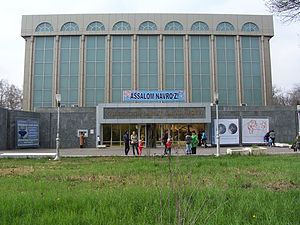Tashkent is its capital and largest city Uzbekistan.
At a glance
| Weather | Jan. | Feb | Mar. | Apr | May | Jun | July | Aug | Sep | Oct | Nov. | Dec |
|---|---|---|---|---|---|---|---|---|---|---|---|---|
| Daily highs (° C) | 6 | 8 | 14 | 22 | 27 | 33 | 36 | 34 | 29 | 21 | 14 | 9 |
| Night low (° C) | -3 | -2 | 4 | 10 | 14 | 18 | 19 | 17 | 12 | 7 | 3 | -1 |
| Rainfall (mm) | 55 | 47 | 72 | 64 | 32 | 7 | 4 | 2 | 5 | 34 | 45 | 53 |
| Sunshine (Hours / day) | 9 | 10 | 11 | 13 | 14 | 15 | 15 | 14 | 13 | 11 | 10 | 9 |
THE Tashkent has a typical continental climate with hot summers and cold winters. The best time to travel to Tashkent is Apr-May and Sep-Oct. | ||||||||||||
Languages
The predominant language in Tashkent is Uzbek.
Religion
Islam
How to get there
![]() By road
By road
![]() By train
By train
![]() By air
By air
How to move
![]() By road
By road
![]() Subway
Subway

Sights
Museums

- Amur Timur Museum (Temuriylar tarixi davlat muzeyi, National Museum of History Timuridov), Amur Timur (ul. Amira Timur) 1 (Amir Temur Xiyoboni Metro Station and half a km east of Yunus Rajabiy Station), ☎ 998 13 36228, 998 71 232-0212, fax: 998 71 232-0213, e-mail: [email protected]. Wed-Sun, 10: 00-17: 00, closed Mon.. Rather kitschy murals depicting Timur. UZS3,000.

Orthodox Churches

Mosques

Local cuisine
Local drinks
Additional destinations
markets
Chorsu Bazaar is located in the heart of the Old Town, next to Chorsu Square - Chorsu Metro Station is there. The word Chorsu comes from the Persian language and means "crossroads". It is the largest and most fascinating oriental market in Tashkent and at the same time the largest and oldest bazaar in Central Asia, operating at the same location for over 2,000 years. The colorful stalls of the bazaar stand under seven huge domes covered with colored tiles. In the largest vaulted building you will find all kinds of spices and cooking herbs: saffron, coffee tree bark, red and black pepper, thyme and cloves, nutmeg, cardamom, as well as raisins and dried apricots, almonds, walnuts and hazelnuts. The bazaar is famous for the peanuts boiled in sugar or honey, covered with sesame. Under the smaller domes are the "workshops". Here the craftsmen make and sell jewelry, dyed bases (beshik), gold embroidery, Uzbek parapets with metallic decorations, embroidered suzanies (thin upholstery), jigsaw (lace for cutting the lower ends of women's trousers), and chapons women's (yashmak) kaftans, kurpacha quilts, pichok knives in leather or brass cases and national musical instruments. The potters offer lyagu dishes and bowls with blue and turquoise painted designs. You will also find rugs from Hiva, the Samarkand, Bukhara and neighboring Afghanistan.
Although the central blue dome of Chorsu Bazaar directly attracts the visitor's attention, the area of the wider market extends in different directions. There are alleys full of makeshift stalls where you can buy products that may have come straight from the farm that morning. There are also countless plastic items for sale that were probably made for just a penny at a Chinese factory and next to Uzbek items, carefully woven traditional clothes and cheap western shirts that you know will not last more than a season. Food is also offered in separate market segments. For example, there is a range of dairy products that sell mostly katik (sour milk like yogurt), local cheeses and of course qurut. The latter is a traditional and very common product of Central Asia. As a rule, they are dry small white soup balls, ranging from 1.5 to 4 or more centimeters in diameter, heavily salted. Sometimes qurut is made in the form of small diamonds, cubes and sticks. It is also sold in pink, with the addition of red pepper and in brown, if smoked.

